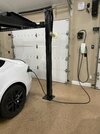Charging an EV is not like running the dryer for 45 minutes to dry your clothes. [snip]... I ran #6 wire to add margin
[snip]... There is a YouTube video from Munro and Associates that talks about this problem. I can't imagine spending $50K on and EV and skimping on the outlet [snip]...
Maybe the wires aren't fully seated or torqued, maybe the breaker is the wrong type, or the bus bars were corroded, maybe a wire is under sized.
I was going to reply with multiple good points you already made.
My biggest concern about this thread is advice that is either not code compliant or is plain wrong. And as the video points out, this is dangerous and is a serious subject. Most localities require permits and code compliance, usually to recent NEC. There are enough complexities and risks that the advice to use a reputable electrician is wise, if not legally required.
During the 4 months between my 2022 M3 OD & DD, I did a LOT of research. I was going 14-50. When I ordered my M3 in May 2023, I also ordered the $200 mobile connector that included 14-50 plug. But passed on the wall connector. I later learned:
1) Latest NEC requires GFCI protection on ALL outlets in garages. A 14-50 thus requires a 60A GFCI breaker; cost- almost $200.
The directly wired Tesla wall connector has code compliant GFCI built in; no additional GFCI is required.
2) All high power wiring has V drop & power loss due to resistance, that generates heat, even when done code compliant. I didn't want power loss & heat. I chose 6 ga wire where 8 ga is typical. Larger gage ground wire is also needed.
As a result, I believe my circuit runs cooler with less V drop. There are YouTube thermal image videos, showing heat all along the circuit. I wanted to reduce that.
3) It's very important to properly secure screw connections. Thick stranded wiring needs to be iteratively tightened, wiggled, and tightened more. A very good connection is very important.
Components are labeled with torque requirements. Use a torque screwdriver or some other means to assure specific torque.
4) 14-50 plugs were designed for low duty cycle (% of time used at rated power) and few plugging cycles. Think dryers and stoves.
Yes, there are heavier duty 14-50 sockets better suited for higher duty cycles. Campgrounds deal with this. RVs and campers use 50A 240VAC 14-50 outlets, resulting in many plugging cycles/year. I guarantee campgrounds don't use $10 or $20 14-50 outlets made by some unknown manufacturer.
5) As the Munro Live video mentions, FIRES with home EV wiring is a significant and GROWING problem, with the acceleration in EV sales. Even professional installs using 14-50 plugs have had fires.
Learning all that, I settled on a direct wired Tesla wall connector, with thicker than typical wiring... All the code compliance boxes were checked.
I'm happy to also have the mobile connector. I've used 50A 14-50 well at campgrounds. I have even gotten a decent charge overnight (while away from home) using a properly wired 120VAC 20A outlet.



